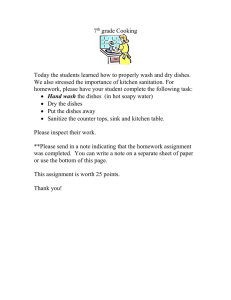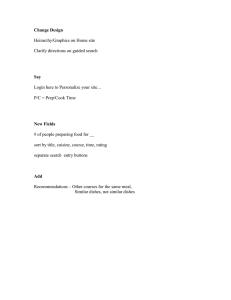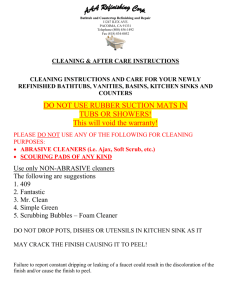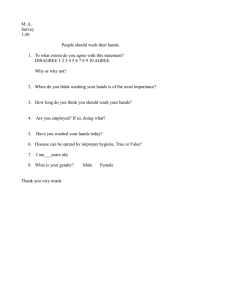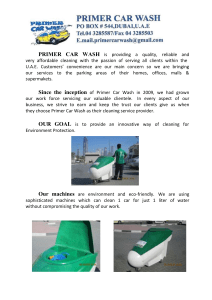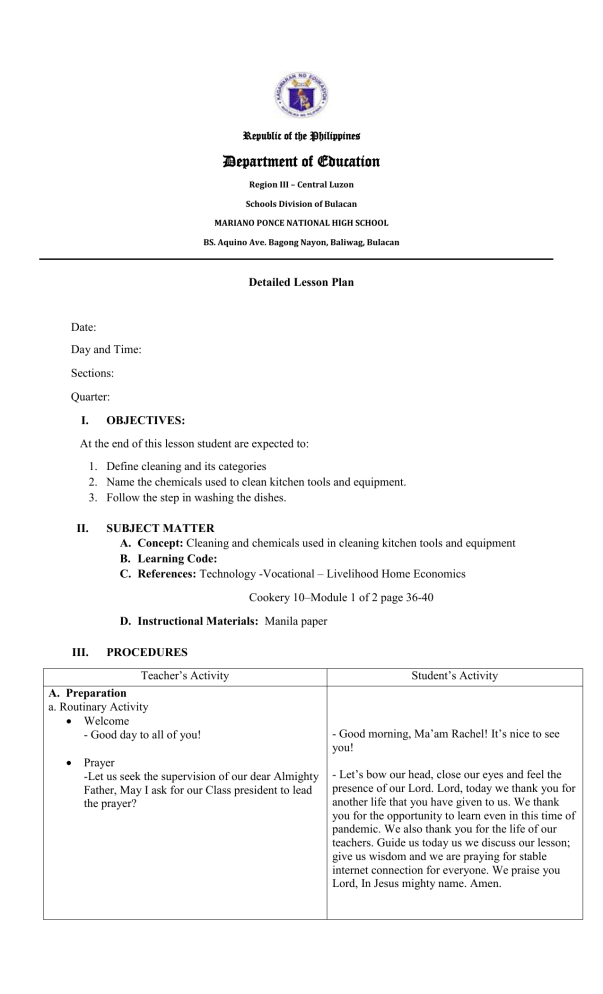
Republic of the Philippines Department of Education Region III – Central Luzon Schools Division of Bulacan MARIANO PONCE NATIONAL HIGH SCHOOL BS. Aquino Ave. Bagong Nayon, Baliwag, Bulacan Detailed Lesson Plan Date: Day and Time: Sections: Quarter: I. OBJECTIVES: At the end of this lesson student are expected to: 1. Define cleaning and its categories 2. Name the chemicals used to clean kitchen tools and equipment. 3. Follow the step in washing the dishes. II. SUBJECT MATTER A. Concept: Cleaning and chemicals used in cleaning kitchen tools and equipment B. Learning Code: C. References: Technology -Vocational – Livelihood Home Economics Cookery 10–Module 1 of 2 page 36-40 D. Instructional Materials: Manila paper III. PROCEDURES Teacher’s Activity A. Preparation a. Routinary Activity Welcome - Good day to all of you! Prayer -Let us seek the supervision of our dear Almighty Father, May I ask for our Class president to lead the prayer? Student’s Activity - Good morning, Ma’am Rachel! It’s nice to see you! - Let’s bow our head, close our eyes and feel the presence of our Lord. Lord, today we thank you for another life that you have given to us. We thank you for the opportunity to learn even in this time of pandemic. We also thank you for the life of our teachers. Guide us today us we discuss our lesson; give us wisdom and we are praying for stable internet connection for everyone. We praise you Lord, In Jesus mighty name. Amen. Checking of attendance -Secretary any one absent? - okay thank you Health check routine -Before we begin our discussion, let's conduct our customary health checks. The class president should check the temperature, and the vice president of the class should examine each chair's social distance. - (Secretary of the class) No one absent ma’am (THE STUDENTS FOLLOWED WELL) B. Review Now, let us have a short review about our last topic, who would like to remained us? Very good! Give same example of kitchen tools and equipment? anyone? C. Motivation -Now, let’s go to our motivational activity, name of this game is jumbled letter: - who want to try number 1.? Jumbled letter: Arrange the following letters below 1._____________ gninaelc 2._____________ abseasvi 3._____________ terdegents 4._____________ dica srenaelc 5._____________ entvsol nersclea (Student raise their hands) (Student answer) Ma’am last time we discussed about the kitchen tools, utensils and equipment. (Student answer) Ma’am scraper is a rubber or silicone tools used to blend or scrape the food from the bowl. (Student answer) Ma’am Serving spoons are small, shallow bowl on a handle used in preparing serving, or eating food (Student answer) Ma’am Oven is chamber or compartment used for cooking, baling, heating, or drying. (Student answer) Cleaning po ma’am (Student answer) Abrasives po ma’am (Student answer) Detergents po ma’am (Student answer) Acid cleaners (Student answer) Solvent cleaners D. Presentation/Lesson Proper (The teacher will discuss the topic through visual aid and sample picture to facilitate learning.) - Since we’ve already discussed the kitchen tools and equipment, we will proceed to our next topic which is about Cleaning and chemicals used in cleaning kitchen tools and equipment. Cleaning-is the process of removing food and other types of soil from surface, such as a dish, glass, or cutting board. Cleaning is done with a cleaning agent that removes food, soil, or other substances. The right cleaning agent must be selected because not all cleaning agents can be used on food-contact surfaces. (A food-contact surface is the surface of equipment or utensil that food normally comes into contact.) For example, glass cleaners, some metal cleaners, and most bathroom cleaners cannot be used because they might leave an unsafe residue on the food contact surface. The label should indicate if the product can be used on a food contact surface. The right cleaning agent must also be selected to make cleaning easy (AND ALL OF THE STUDENTS ARE LEASEANING) (Student will raise their hands) - Question: how do you clean your room? Anyone? Okay very good (Student answer) First, bring in a garbage bag and pick up trash around the room. Getting garbage out of the way ensures you'll avoid spills or soiling linens while cleaning. After that, make the bed and shake off the sheets and pillows. -Continue our discussion - and now we discuss the different cleaning agent or compound the first one is Cleaning Compound Detergents These are cleaning agents, solvents or any substance used to wash tableware’s, surfaces, and equipment’s. Example: soap, soap powders, cleaners, acids, volatile solvents and abrasive Solvent Cleaners commonly referred to as degreasers, they are used on surfaces where grease has burned on. Ovens and grills are examples of areas that need frequent degreasing. These products are alkaline based and are formulated to dissolve grease. Acid Cleaners used periodically in removing mineral deposits and others oils that detergents cannot eliminate such as scale in washing machines and steam tables, lime buildup on dishwashing machines and rust on shelving. (Example: phosphoric acid, nitric acid, etc.) These products vary depending on the specific purpose of the product. Abrasives are generally used to remove heavy accumulations of soil that are difficult to remove with detergents, solvents and acids. These products must be carefully used to avoid damage to the surface being cleaned. -Do you have any questions before we continue? - but before that I have a question how you wash your dishes at home? what the first item you wash? - okay thank you let as see if your answer if it’s a correct way to wash the dishes - okay we continue, now we proceed in how the proper way how to wash the dishes 1.Wear rubber gloves if you have dry hands or other skin problem. If you are wearing long sleeves, roll them up or put them under the gloves. Wear aprons too. 2. Scrape all the large pieces of food on the dishes and place it in a compost bin or garbage can. 3. Stack the dishes in the proper order namely: glassware, silverware, chinaware, and utensils. Stack them to the right of the sink so that work progresses from right to left. 4. Fill the sink with water (ALL OF THE STUDENTS ANSWER NONE MAAM) (Student answer) -Put liquid detergent in a bowl and then wash the plate to put the glasses on. and add a considerable amount of detergent. The hotter the water, the better it’s sanitizing and grease-cutting properties but use tolerable heat (66 ° C /150 ° F or above) so not to scald yourself. Use rubber gloves. 5. Wash the lightest soiled items first. Start with glasses, cups, and flatware. Soap each piece individually and rinse in hot water. 6. Wash plates, bowls, and serving dishes. Remember to scrape these items before washing. Soap each piece gently and individually and rinse in hot water. Remember to keep an eye when you should change the dish washing water. 7. Wash pots and pans last. Soak them first. Wash the pans thoroughly and don’t forget to clean the bottoms. If anything was burnt or overcooked to pots or casserole dishes, put a little extra soap and water in it and let it stand while you wash the other dishes. Take note that any oil residue left will lead to burnt food during the next cooking session. 8. Lay your dishes out on a rack to air-dryer wipe them clean with a towel. 9.There should be no visible matter and no "greasy" feel. Run a hand over the dish to ensure that they are thoroughly cleaned. If there are still some greases remaining, consider rewashing the item. - Any question? - Okay we continued (ALL STUDENTS ANSWER) NONE MAAM) Tips and warnings to observe in washing the dishes Wash glassware first before greasy pots and pans. Rubber gloves will protect hands and manicures, and allow you to use hotter water for washing and/or rinsing. Dishes may be hand dried with a clean cloth. Try adding a tablespoon of baking soda to soapy water to soften hands while cutting grease. Never dump sharp knives into soapy dishwater where they cannot be seen. Laundry detergents or automatic dishwater detergents should not be used for hand washing dishes. Keep dishwashing liquid out of the reach of children -Cleaning eliminates germs along with dirt and dust, resulting in better indoor air quality, leaving a whiff of freshness in its wake. The kitchen usually requires special attention, as they are known to be one of the germiest places in any house And also, to avoid sick because of dirt surrounding at home. -You understand the lesson, class? - okay I hope you lean something today (ALL STUDENTS ANSWER) YES MAAM) IV. Generalization - Recognized cleaning compound in kitchen tools and instructions for washing dishes correctly and sequentially V. Application Students give some examples of cleaning compound that are commonly used at home. Why is it important to understand how to clean and properly use cleaning compounds after using kitchen utensils or tools? ? Any one - Okay very Good VI. To prevent pathogens such as viruses, bacteria, and molds from spreading to your food. When you use your tools to prepare raw food, pathogens from the raw food transfer to your tools. Evaluation (ALL STUDENTS ANSWER THE 20 ITEAM QUIZ) Part 1: Multiple choice: Choice the correct answer: 1. Ann had a hard time removing heavy soils from pots and pans. What will you suggest to solve her problem? a. Solvent cleaner c. Abrasive b. Detergent d. Acid cleaner 2. In cleaning the kitchen, this cleaning agent is helpful and it can be used every day or on a regular basis. Which cleaning agent is this a. Detergent c. Abrasive b. Acid cleaner d. Degreaser 3. Which of the following is commonly known as 'degreasers'? a.Detergents c. Acid cleaners b.Solvent Cleaners d. Abrasives 4.Which among the following cleaning agents are solvents or any substance used to wash table wares, surfaces and equipment? a. Abrasives c. Detergents b. Acid cleaners d. Solvent cleaners 5. Dish washing soaps and liquids are examples of cleaning compounds as ___________________ a.Abrasives c. Solvent cleaners b.Acid Cleaners d. detergents 6. This cleaning agent is essential in removing mineral deposits in the kitchen. a.Abrasive c. Acid cleaner b.Detergent d. Solvent cleaner 7.Cleaning is vital in every kitchen because ___. a.It removes all the types of soil from a dish or tools/equipment b.It removes bacteria or disease-causing elements. c.It makes the kitchen free from living microorganisms. d.It can be free from dirt, germs etc. 8.What is the 5th step in washing dishes? a.Wash plates, bowls and serving dishes b.Lay your dishes out on the rack to air-dry or wipe them clean with a towel c.Scrape all the large pieces of food on the dishes and plate it in a compost bin or garbage can. d.Wash the lightest soiled items first. 9.What is the step 2th in washing dishes? a.Wash plates, bowls and serving dishes? b.Lay your dishes out on the rack to air-dry or wipe them clean with a towel c.Scrape all the large pieces of food on the dishes and plate it in a compost bin or garbage can. d.Wash the lightest soiled items first. 10.What is the step 8th in washing dishes? a.Wash plates, bowls and serving dishes? b.Lay your dishes out on the rack to air-dry or wipe them clean with a towel c.Scrape all the large pieces of food on the dishes and plate it in a compost bin or garbage can. d.Wash the lightest soiled items first. Part 2 answer the following question below: (5pts each) 1.What are the procedure on how wash regular dishes? 2.Step in washing dishes? V. ASSIGNMENT Assignment: list at least ten cleaning agents or compounds that are commonly found at home and explain in front of the class where you use them most frequently. Prepared by: RACHEL C. LANSANGAN Practice Teacher Checked: ANGELO M. CRUZ Critic Teacher
